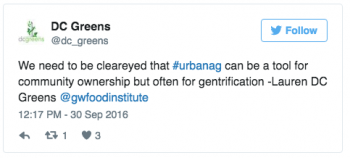Uncomfortable Questions about Urban Ag
This blogpost was co-authored by Claire Fitch and Carolyn Hricko.
Urban agriculture is a topic that can get tricky, fast. Once the glow of growing food in urban spaces fades, big, complex questions arise: What are the goals? Who is it serving? Who is, and will be, the face of urban agriculture? With Farm Bill discussions ramping up, these questions become even more important.
On September 30, we went to a symposium on Urban Agriculture in the Next Farm Bill held at George Washington University. The event featured policymakers, academics, practitioners and entrepreneurs in the urban agriculture movement. The day’s discussions ranged from the role of government and legislation, to social justice, innovations and financing, to the viability of urban agriculture. At the opening of the symposium, the organizers announced that we would be using Pigeonhole, an interactive online Q&A platform that lets audience members submit and vote for questions. The questions are automatically uploaded to the screen onstage, arranged so that those with the most number of votes rise to the top. My first thought was, “Are we so dependent on technology that we can’t speak anymore?” But after a tense transition between panels, I saw the value of this technology.
The first panel, Social Justice and Urban Agriculture, featured speakers from Black Urban Growers, DC Greens, and the Detroit Black Community Food Security Network discussing the gap in resources and grant opportunities between rural and urban agriculture. They lamented the fact that so little of the funding from current Farm Bill programs has been designated for urban efforts, despite the growth in this sector and the needs of food insecure communities. They also spoke frankly about the misguided efforts by wealthy, white urban dwellers to bring community gardens to poor, black neighborhoods; aside from not effectively addressing food insecurity or respecting the community’s own traditions, an influx of white-led urban agriculture endeavors could forecast a rise in rent prices and gentrification. Urban agriculture efforts are best left up to the community, they said, and well-intentioned outsiders should support these communities by handing over power and resources.
 The next panel, the Business of Urban Agriculture, an all-white panel of (mostly) D.C. urban ag entrepreneurs, discussed their ventures in hydroponics, artisan microgreens, and home garden assistance. Some of the panelists talked about the education and outreach components of their companies and efforts to hire staff from the communities in which they work, but the discrepancy between this panel and the previous one was palpable. One panelist from D.C. praised the Farm Alliance of Baltimore–a facilitator of shared resources, facilities, and equipment for a network of urban farms in Baltimore City with the mission of increasing the viability of urban farming and improving access to local food–as a model that should be funded and replicated in other cities through the next Farm Bill. But we know from our work in Baltimore that the Farm Alliance has had its own share of challenges creating a unified effort with support from local communities, serving as a reminder that urban ag collectives are an important and promising resource, but that their existence does not ensure community buy-in or equity.
The next panel, the Business of Urban Agriculture, an all-white panel of (mostly) D.C. urban ag entrepreneurs, discussed their ventures in hydroponics, artisan microgreens, and home garden assistance. Some of the panelists talked about the education and outreach components of their companies and efforts to hire staff from the communities in which they work, but the discrepancy between this panel and the previous one was palpable. One panelist from D.C. praised the Farm Alliance of Baltimore–a facilitator of shared resources, facilities, and equipment for a network of urban farms in Baltimore City with the mission of increasing the viability of urban farming and improving access to local food–as a model that should be funded and replicated in other cities through the next Farm Bill. But we know from our work in Baltimore that the Farm Alliance has had its own share of challenges creating a unified effort with support from local communities, serving as a reminder that urban ag collectives are an important and promising resource, but that their existence does not ensure community buy-in or equity.
When the audience’s questions were broadcast to the screen, the following question resonated with the crowd and demanded attention: “There is clearly less racial diversity on this panel than the last. What can be done to shift the demographic of those engaged with urban ag as a viable business endeavor?” Rather than creating distance between the audience and the panel with anonymous text, Pigeonhole created space for an honest, open discussion about a topic that may have been too uncomfortable for some audience members to broach on their own. While the ensuing discussion didn’t resolve the unease surrounding the question, it did create the space to begin a much needed conversation. This question could, and should, lead to many more. As we asked earlier, What are the goals of urban agriculture? Which communities should it serve, and is its purpose to create viable businesses, alleviate food insecurity, or both? Who is, and will be, the face of urban agriculture? With Representative Marcy Kaptur (D-Ohio) planning to reintroduce urban agriculture legislation in Congress and Senator Debbie Stabenow (D-Michigan) spearheading the Urban Agricultural Act of 2016, this conversation is far from over. As work to integrate support for urban agriculture into the Farm Bill ramps up, it will be important to keep in mind the words of Karen Washington, co-founder of Black Urban Growers in New York City and symposium panelist: “Always remember who’s in the room, who isn’t, and who needs to be there.”